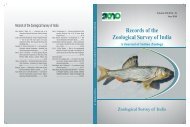Andaman booklet aw.FH10 - Zoological Survey of India
Andaman booklet aw.FH10 - Zoological Survey of India
Andaman booklet aw.FH10 - Zoological Survey of India
You also want an ePaper? Increase the reach of your titles
YUMPU automatically turns print PDFs into web optimized ePapers that Google loves.
<strong>Andaman</strong> Wood Pigeon Columba palumboides: This is one <strong>of</strong> the<br />
Near Threatened species, endemic<br />
to the <strong>Andaman</strong> and Nicobar Islands<br />
(BirdLife International, 2001,<br />
Stattersfield et al., 1998). It is an<br />
uncommon bird in the <strong>Andaman</strong>s,<br />
but small parties wander from one<br />
island to another. It has been<br />
reported from Mount Diavalo/Cuthbert Bay, Mahatma Gandhi Marine<br />
National Park, Interview Island Wildlife Sanctuary, Car Nicobar,<br />
Chainpur and Hanspuri, Great Nicobar, Little Nicobar, Little <strong>Andaman</strong>,<br />
and other IBA sites (Islam and Rahmani, 2009).<br />
<strong>Andaman</strong> Cuckoo Dove Macropygia rufipennis : The <strong>Andaman</strong><br />
Cuckoo Dove is found in dense, broadleaf, primary and secondary<br />
evergreen forest. It is reported from Mount Diavalo/Cuthbert Bay,<br />
Mahatma Gandhi Marine NP (Wandoor NP), Interview Island WLS,<br />
Car Nicobar, Chainpur and Hanspuri, Great Nicobar, Little Nicobar,<br />
Little <strong>Andaman</strong>, and other IBA sites.<br />
<strong>Andaman</strong> Coucal Centropus andamanensis : The <strong>Andaman</strong> Coucal<br />
or Brown Coucal is Near Threatened and endemic to these islands<br />
and is found in forest-edge gardens, cultivation and mangrove areas.<br />
It is mainly reported from the Table and Coco islands, Middle<br />
<strong>Andaman</strong>, South <strong>Andaman</strong>, and Little <strong>Andaman</strong> (Stattersfield et al.<br />
1998).<br />
<strong>Andaman</strong> Scops Owl Otus balli: It is a Near Threatened species,<br />
endemic to the <strong>Andaman</strong> Islands, where it is common and can be<br />
seen in trees in semi-open or cultivated areas and around human<br />
settlements (del Hoyo et al., 1999). This Owl has been reported<br />
mainly from Narcondam, South <strong>Andaman</strong>s, Middle <strong>Andaman</strong>s, North<br />
<strong>Andaman</strong>s, Baratang Island and from several outlying islands (Islam<br />
and Rahmani, 2009).<br />
20
















